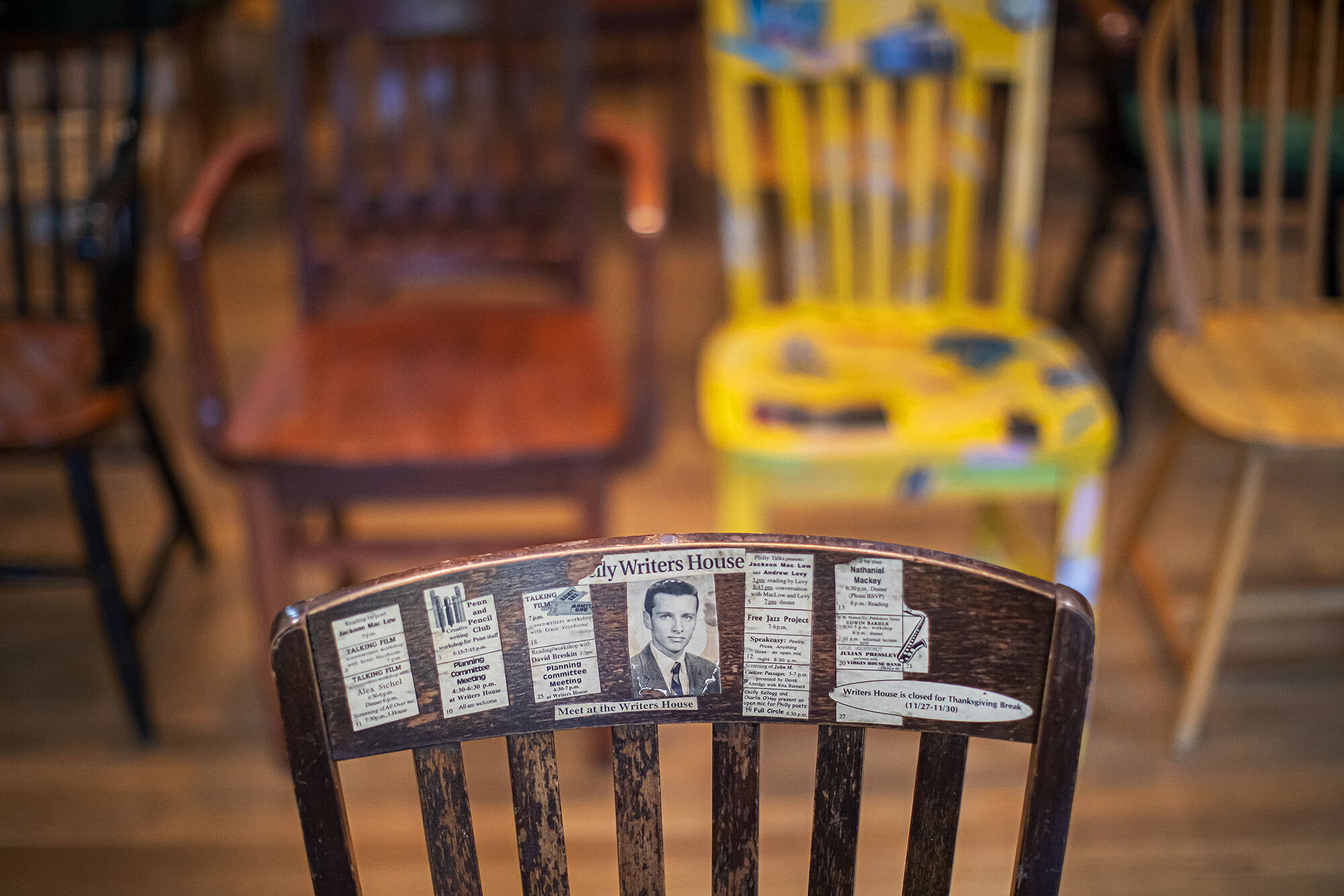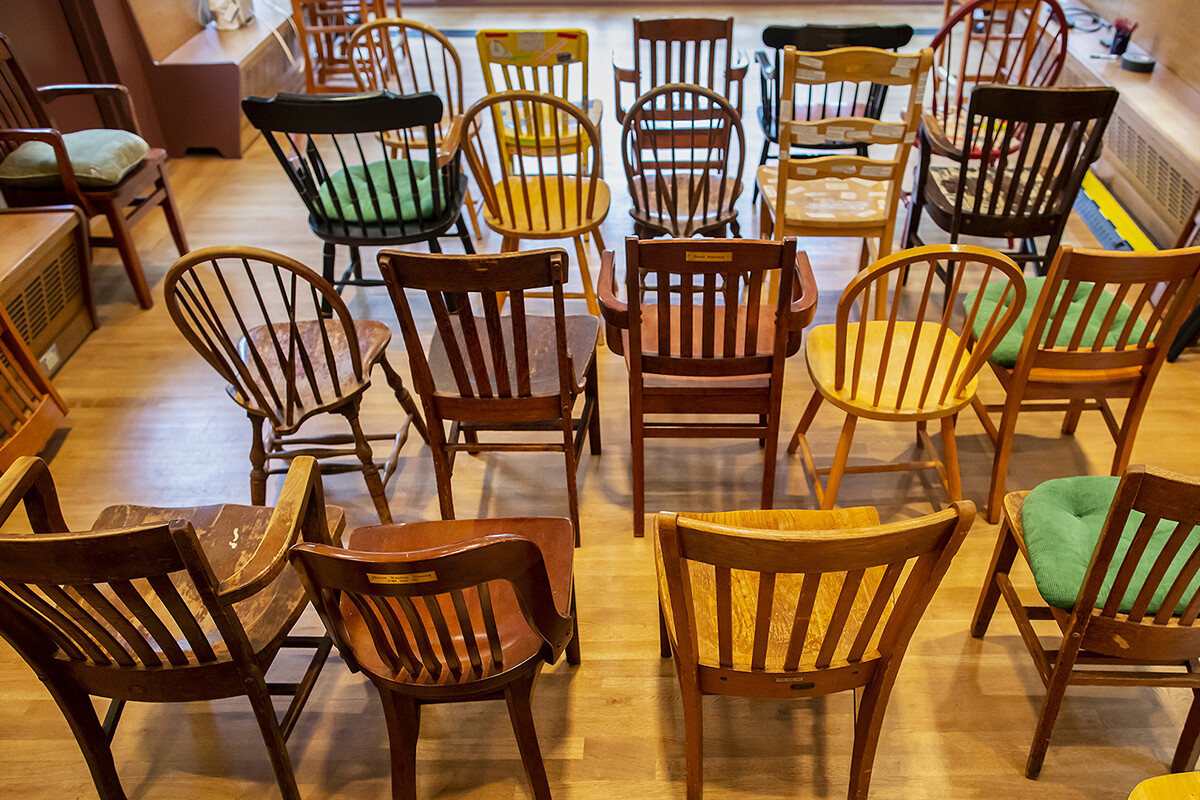
(From left) Doctoral student Hannah Yamagata, research assistant professor Kushol Gupta, and postdoctoral fellow Marshall Padilla holding 3D-printed models of nanoparticles.
(Image: Bella Ciervo)

Even the chairs at Kelly Writers House have stories to tell.
The mismatched wooden seats came from the community, intentionally given to become part of Writers House everyday history. Among them are scuffed straight-backed library chairs, curved mahogany ones with brass plaques, and Windsor chairs from a professor’s dining room set.
Five are decoupaged with words and pictures: the haiku chair, the banned books chair, the six-word-memoir chair, even a chair chair, also called the meta chair. The Paul Kelly chair is the oldest, a nod to Writers House origins a quarter-century ago, the photos and headlines worn around the edges, especially in the seat.
“The Paul Kelly chair is my favorite. I sit in it as often as I can,” says Al Filreis, Kelly Writers House founder and faculty director. “Paul was our first benefactor, was the first person really to see the great value in what we were creating, and so I’m delighted that his personal story is told in the photos embedded in that comfy old chair.”
The chairs are so much more than their dictionary definition: a seat typically having four legs and a back for one person.
“It is both metaphorical and literal a sense of community coming together to help make a space,” says Jessica Lowenthal, Kelly Writers House program director. “The chairs represent the contributions of many different people conceiving and stocking the space with things and ideas and work.”
Kelly Writers House was founded in 1995 as a center for creative writing, a home for student publications and academic classes, as well as a literary event space for conversations with authors, artists, and musicians. Those first planning sessions were “bottom-up directed,” collaborative, participatory, democratic, Filreis says. Combined with the fact that they had very little money, the organizers decided to crowdsource the chairs.
Citizens of The Hub, the founding planning group, were asked to go out into Philly neighborhoods on a sunny mid-autumn Saturday and buy used wooden chairs at flea markets and street fairs and garage sales, or bring them from home. “People came back with some beauties, and some of these from fall 1995 are still there,” says Filreis. “And that has continued to serve as a model for our chairs.”
Located at 3805 Locust Walk, Kelly Writers House, built in 1851, is one of the oldest buildings on Penn’s campus. The 13-room house has gone through several renovations, but the Gothic cottage has retained its character.
The Arts Cafe event space, home to most of the 50 crowdsourced wooden chairs, has undergone a major renovation during the past year. The room was expanded to include the footprint of the front porch, with a bank of paned windows reminiscent of the ones in the former bay, as well as new heating and air conditioning and lighting, and the latest in sound and video recording equipment.
New wooden benches, that match the crown molding, now add seating along both sides, complementing the mismatched chairs.
“Our goal with the renovation was to elicit a response like this: ‘Wow, I know you really fixed up the space, but it really looks like the old Arts Cafe. What has changed? And you kept the old chairs.’ We aimed for that and that’s what we got. Design rarely works so well,” Filreis says.
Some of the older chairs had to be culled, despite two ambitious “chair repair” days over the years. And the space is larger. So, they put out another call to the Writers House community.

“We said: Please find a chair, bring a chair, if you know a chair, if you have a chair, we want your chair,” Lowenthal says. (The Writers House has a stock of about 70 folding chairs it uses to accommodate some events, when seats are set up in both the Arts Cafe and the adjacent living room.)
“To have all new chairs would be to say this an all-new space. But in fact, what we wanted was a space that felt the same, that read the same, that had its history intact but would allow us to do more,” she says. “So, adding new-old chairs was the way to go, rather than finding new chairs that would allow us to fit more people.”
In the new room with more space and a new footprint, they are playing with configurations, she says, trying circles, ovals, lined up facing one way, and the other. “They aren’t just objects to be used,” Lowenthal says. “They are objects to be manipulated, moved, discussed.”
The red Windsor banned books chair is covered in a collage of titles, the idea of then-student Kaegan Sparks, a 2010 graduate. The green Windsor featuring pictures of chairs was also her idea.
The maple haiku chair has poems from the Writers House community, typed out in different fonts, done to honor a former program director. Six-word memoirs, an ongoing literary project at Writers House, fill a bright yellow chair. “‘These years writing about those ones,’ is perfect, as a writer thinking about your life,” Lowenthal says.
Some of the seats are more comfortable than others. A set of chairs was purchased through donations from a program years ago: brass plates with names are on the backs. Those are Lowenthal’s choice for visiting authors. “These are really comfortable, really sturdy,” she says, picking one up by the back. “They have a nice curve and they don’t creak.”
But even the slightly uncomfortable and slightly creaky chairs are loved.
“There’s a combination of old-fashioned warm feel and real discomfort in those chairs. Few people fall asleep in them. You have to feel just a little bit out of your comfort zone at a Writers House program, and our chairs support that vision,” Filreis says. “Funny how architecture—the real things in a house—is destiny.”
Al Filreis is the Kelly Family Professor of English, director of the Center for Programs in Contemporary Writing, and faculty director of Kelly Writers House.
Louisa Shepard

(From left) Doctoral student Hannah Yamagata, research assistant professor Kushol Gupta, and postdoctoral fellow Marshall Padilla holding 3D-printed models of nanoparticles.
(Image: Bella Ciervo)

Jin Liu, Penn’s newest economics faculty member, specializes in international trade.
nocred

nocred

nocred